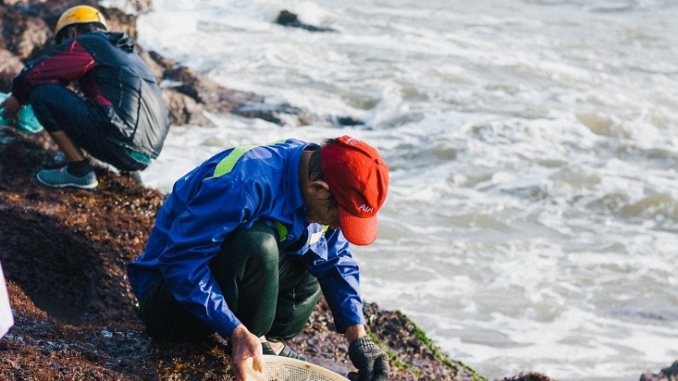
This is a specialty that grows naturally on rocky cliffs but only appears in winter, from September to January of the next lunar year, with a selling price of up to 3.5 million VND/kg dry.($1=25,000 VND)

From the beginning of September to December of the lunar calendar, people in coastal communes of provinces such as Quang Nam, Quang Ngai, Binh Dinh, Khanh Hoa, and Kien Giang… go to the rocky beaches to get “sea luck”.

This is a precious vegetable with high nutritional value that many people buy to cook soup, make Tet jam, snacks or as gifts.

Seaweed grows on coastal rocks. When it gets cold and rainy, they multiply very quickly.

To harvest seaweed jam, people have to go early in the morning, when the tide recedes.

They use pieces of aluminum, beer bottle caps or spoons to scrape jam from slippery rocks.

In recent years, seaweed jam has been favored by many people, purchased at high prices, so in the season, people invite each other to hunt for “sea treasures”.

The collected seaweed will be sold fresh for 250-350 thousand VND/kg.

Or dried into small cakes, sold for from 650 thousand VND to millions of VND/kg.

The seaweed jam in Tam Hai, Nui Thanh district (Quang Nam) is said to be the most expensive, from 3-4.5 million VND/kg.

Normally, to have 1kg of dried seaweed, you have to dry 6-7kg of fresh seaweed.

Seaweed jam, also known as seaweed jam, black seaweed, scientifically known as Porphyra, belongs to the red algae Rhodophyta.

According to scientists, this type of seaweed has nutritional content dozens of times higher than other types of seaweed.

They contain amino acids, vitamins B, B2, A, C and trace elements, minerals necessary for the body.

Jam can be processed into many dishes such as cooking soup, drying, mixing salad, stir-frying meat.

Harvesting jam can also bring in millions of VND/day for coastal people in the season.
Photo: Internet (vinlove.net)
